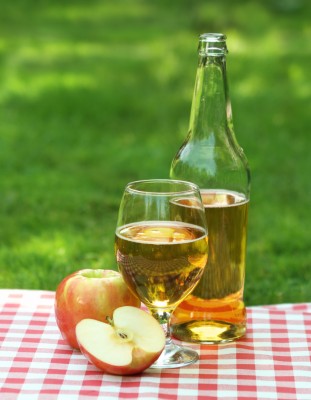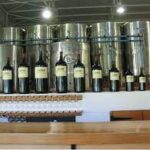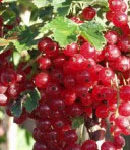Soki na wino – przepisy

Sok z jabłek, gruszek i winogron.
Soków z tych owoców zazwyczaj się nie słodzi, można powiedzieć, że pasteryzuje się je w czystym stanie naturalnym. Tylko w latach niekorzystnych dla win i owoców można dodać nieco cukru. W tym celu rozpuszcza się niewielką ilość cukru bezpośrednio w soku – jedynie gdy sok jest bardzo kwaśny, w wodzie – i miesza się z całością płynu. Aby osiągnąć odpowiedni smak soku, można na ogół polegać na własnym wyczuciu (na 1 litr soku około 5-10 g cukru) bądź też można określić zawartość cukru i kwasowość tak, jak to opisano dalej.
Sok z malin
Maliny zawierają stosunkowo mało kwasów, dlatego też najczęściej miesza się je z czerwonymi porzeczkami, które charakteryzują się dużą kwasowością. Przyrządzając czysty sok malinowy, dodaje się do niego kwas winowy: na 1 litr soku 0,6 litra (600 g) wody, w której rozpuszcza się uprzednio 15 g kwasu winowego. Do tego dodaje się cukier i dla uszlachetnienia smaku 1/4 litra czerwonego wina. Im mocniej osłodzi się sok, tym bardziej staje się on podobny do syropu i do picia trzeba go znów rozcieńczać.
Jeśli sok zawiera dużo cukru (to znaczy na jeden litr ponad pół kilograma cukru), nie zachodzi potrzeba dodatkowej pasteryzacji. Jeżeli stoi on w chłodzie, przechowuje się dobrze przez pewien czas. Sok do dłuższego przechowywania lepiej jest jednak pasteryzować.
Sok z porzeczek
Sok przesącza się przez płótno, słodzi (około pół kilograma cukru na litr), uszlachetnia się go 1/4 litra czerwonego wina, napełnia się nim butelki i pasteryzuje. Czerwone wino można zastąpić rumem lub czystą wódką (dwa do czterech kieliszków na litr).
Sok z wiśni
Sok z wiśni słodzi się do smaku. Dodaje się do niego na jeden litr soku 1/4 litra dobrego czerwonego wina, 4 g cynamonu i 4 g goździków. Po ośmiu dniach filtruje się sok i pasteryzuje się go w butelkach. Aromat soku można poprawić przez dodanie kilku rozgniecionych pestek wiśni, ale nie powinno się brać ich zbyt wiele, ponieważ zawierają trujący kwas pruski (smak gorzkich migdałów).
Sok z czarnego bzu
Wyciśnięty sok słodzi się (na jeden litr 200 g cukru) i pasteryzuje.
Z wytłoczyn można zrobić przecier. Dziki bez jest niezwykle stabilny, bardzo trudno wywołać w nim proces fermentacji, a poza tym trzeba go ogrzać, aby zawarta w nim sambunigryna straciła kwas, niszczący błonę śluzową żołądka.
W zasadzie wszystkie te przepisy są jednakowe. Pewną odmianę można osiągnąć mieszając owoce ze sobą, na przykład jabłka z jeżynami, truskawki z rabarbarem, tarninę z gruszkami, a porzeczki z malinami. Dodatek różnych przypraw może znacznie poszerzyć paletę odcieni smakowych.
Oto kilka propozycji.
Aromat owocowy soków zyska na intensywności, jeśli wzbogaci się je likierem lub wódką zrobioną z tego samego gatunku owoców; do gruszek dodaje się destylat wina gruszkowego, do mirabelek wódkę mira-belkową względnie likier mirabelkowy lub morelowy, a do jabłek – calvados. Inne, ale nie mniej bogate smakowo efekty daje dodatek różnych wysokoprocentowych napojów alkoholowych, takich jak rum, whisky, koniak, a także jałowcówka, gin lub wódka. Nie należy jednak zapominać, że alkohol ma służyć jedynie jako przyprawa i nie może zamieniać soku owocowego w rodzaj likieru.
Dodatek wina białego, czerwonego lub różowego, w zależności od barwy soku, wzmacnia jego aromat. Także w tym wypadku trzeba odpowiednio wyważyć proporcje.
Przyprawy dodaje się do miazgi przed wyciśnięciem soku, bądź też do gotowego soku i po osiągnięciu przez odpowiednią przyprawę pożądanego efektu sok ponownie trzeba przefiltrować.
Do wszystkich owoców, które zawierają niewielkie ilości naturalnych kwasów, powinno się dodać cytrynę. Poza tym nie istnieją żadne ogólne reguły. Najlepiej samemu wypróbować rozmaite dodatki. Dobrze harmonizują ze sobą:
– kandyzowana skórka pomarańczowa i jarzębina,
– kandyzowana skórka cytrynowa i melon,
– wanilia i agrest,
– anyżek oraz koper włoski i śliwki węgierki,
– goździki oraz cynamon i wiśnie lub czereśnie,
– imbir i melon,
– kolendra i gruszka oraz pigwa,
– jałowiec oraz kminek i jabłka,
– gałka muszkatołowa i pomarańcze.
Podobnie jak podczas gotowania czy pieczenia również w tym przypadku należy mieć na uwadze zasadę: lepiej za mało niż za dużo, bo bardzo łatwo można zepsuć delikatny smak soku owocowego nazbyt dużym dodatkiem przypraw.
Do sporządzania soków owocowych potrzebne są:
-butelki albo słoiki z nakrętkami twist-off (np. stoiki po dżemie lub butelki po ketchupie)
-gumowe kapturki albo korki
-przyrządy do rozdrabniania owoców:
maszynka do mięsa z przystawką lub elektryczna sokowirówka lub prasa, młynek, tłocznia do owoców lub – dla najprostszej metody – płótno i stołek -specjalny garnek do pasteryzacji butelek
-lejek do napełniania butelek (emaliowany, aluminiowy lub plastikowy)
-kubek z podziałką, drewniana łyżka do mieszania, chochla, czyste ściereczki, waga kuchenna, wąż gumowy do napełniania, cukier, parafina lub płynny wosk pszczeli.





